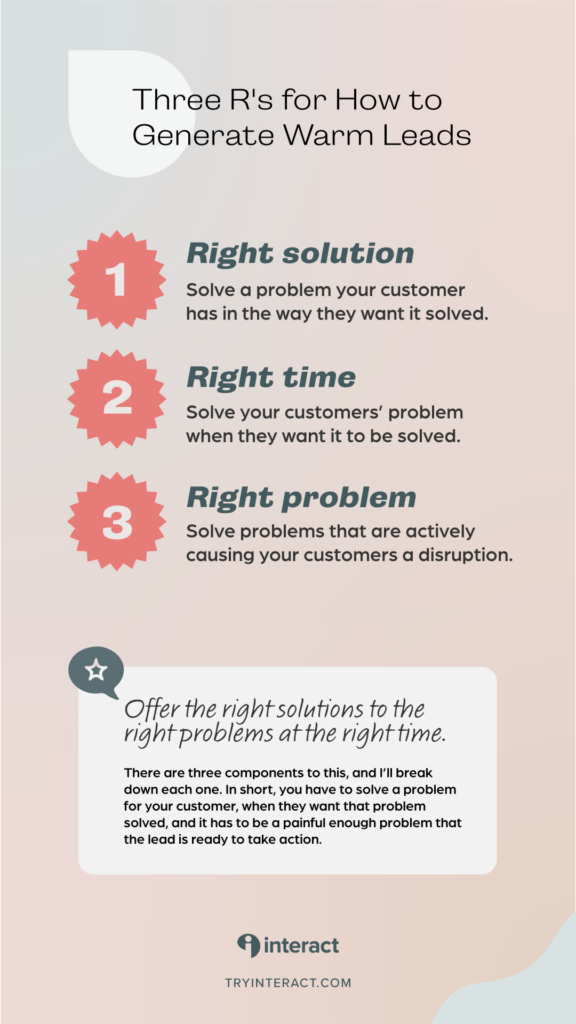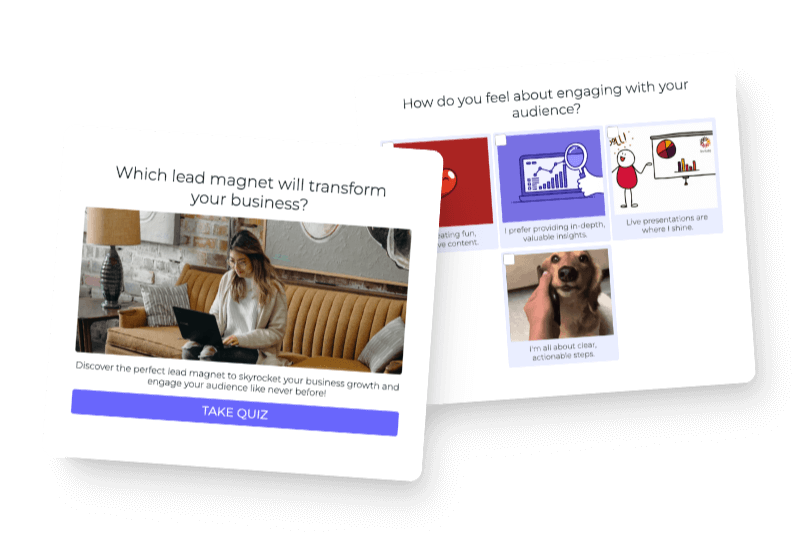A few years ago, we worked on a campaign with a national brand. The brand brought in 600 leads with their quiz in the first few days, but then they reported zero sales from those leads. That’s a lot of leads for no results, and there are many reasons for the failed initiative, but suffice it to say, those were not warm leads.
We’ve also worked with countless businesses that have brought in five to ten leads a day and made sales off each batch of people who came through the door. What matters is not how many leads you bring in, but whether or not they are ready to buy. Let’s talk about what works for bringing in warm leads.
What are warm leads?
Warm leads are people who are actively searching for solutions to a problem and are ready to buy a product or service.
How do I generate warm leads?

Offer the right solutions to the right problems at the right time. There are three components to this, and I’ll break down each one. In short, you have to solve a problem for your customer, when they want that problem solved, and it has to be a painful enough problem that the lead is ready to take action.
The right solution
Solve your customers’ problems in the way they want them solved.
At Interact, a problem our customers have is that they need to make a quiz. There are many ways they can accomplish this, ranging from a full-service agency to a DIY tool for creating quizzes.
Over time, we learned that our customers don’t want full-service because we work with small and medium businesses that can’t afford to spend $5,000 to $10,000 for that type of service. But they also don’t want to be given a blank slate and be told they’re on their own.
They want ready-to-use, fully customizable templates that they can edit or use without any writing or modification.
If you want to generate warm leads, you have to offer a solution in the way your customers want it to be presented. You can’t just say, “Here’s a way to solve your problem. Go for it.” You have to understand what your customer wants to do and how they want to do it, then offer that solution in return for the customers’ contact information.
The right time
Solve your customers’ problems when they want them to be solved.
The right offer at the wrong time is still the wrong offer.
In 2013, we reached out to prospective customers at Interact—most of them declined our offer. At the time, it was still really easy (and legal) to get lists of leads and just start emailing those people. In 2018, after privacy laws started passing and the market for lead generation got more competitive, we reached out to those same people. Most of them said yes to using quizzes for lead generation.
We weren’t doing anything wrong the first go-round. The timing just wasn’t right, and the market wasn’t in a place where quizzes could be received—we heard crickets. The second time, we succeeded with the same exact offer because conditions had changed and people were receptive to our idea.
There’s not a simple fix for knowing the right time to present an offer. It’s more about talking to your customers and understanding what they’re thinking about and which problems are top of mind, so you can make sure to meet them where they are.
The right problems
Solve problems that are actively causing your customers a disruption.
Most businesses exist because they solve disruptions in people’s lives, and those people are willing to pay money to get rid of the disruption. Interact’s quizzes do a bunch of things: they give deep insights into customer psychographic profiles, help make connections between leads and their interests, and a whole lot more.
But, those are all secondary problems, not primary problems. The primary problem we help customers fix is that they need more leads. So when we go to generate leads for a company, we don’t start with secondary problems. We start with “Use a quiz to generate leads” because that’s the most significant point of disruption we can help with.
This doesn’t mean you never talk about secondary or tertiary benefits, but it does mean that when you go to generate leads, you have to bring up a problem that’s big enough that someone will want to opt-in for a solution.
Conclusion
The right solution at the right time for the right problems. If you check all three of those boxes, you’ll bring in warm leads who are ready to make a purchase and won’t waste your time or clog up your systems with people who end up unsubscribing.
As you plan out marketing campaigns, think about the three R’s. You’ll save yourself a lot of time and money.
